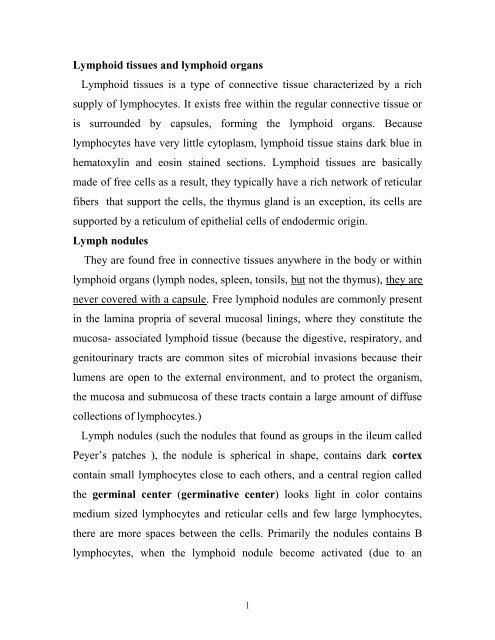lymphoid nodules
lymphoid nodules
lymphoid nodules
Create successful ePaper yourself
Turn your PDF publications into a flip-book with our unique Google optimized e-Paper software.
Lymphoid tissues and <strong>lymphoid</strong> organs<br />
Lymphoid tissues is a type of connective tissue characterized by a rich<br />
supply of lymphocytes. It exists free within the regular connective tissue or<br />
is surrounded by capsules, forming the <strong>lymphoid</strong> organs. Because<br />
lymphocytes have very little cytoplasm, <strong>lymphoid</strong> tissue stains dark blue in<br />
hematoxylin and eosin stained sections. Lymphoid tissues are basically<br />
made of free cells as a result, they typically have a rich network of reticular<br />
fibers that support the cells, the thymus gland is an exception, its cells are<br />
supported by a reticulum of epithelial cells of endodermic origin.<br />
Lymph <strong>nodules</strong><br />
They are found free in connective tissues anywhere in the body or within<br />
<strong>lymphoid</strong> organs (lymph nodes, spleen, tonsils, but not the thymus), they are<br />
never covered with a capsule. Free <strong>lymphoid</strong> <strong>nodules</strong> are commonly present<br />
in the lamina propria of several mucosal linings, where they constitute the<br />
mucosa- associated <strong>lymphoid</strong> tissue (because the digestive, respiratory, and<br />
genitourinary tracts are common sites of microbial invasions because their<br />
lumens are open to the external environment, and to protect the organism,<br />
the mucosa and submucosa of these tracts contain a large amount of diffuse<br />
collections of lymphocytes.)<br />
Lymph <strong>nodules</strong> (such the <strong>nodules</strong> that found as groups in the ileum called<br />
Peyer’s patches ), the nodule is spherical in shape, contains dark cortex<br />
contain small lymphocytes close to each others, and a central region called<br />
the germinal center (germinative center) looks light in color contains<br />
medium sized lymphocytes and reticular cells and few large lymphocytes,<br />
there are more spaces between the cells. Primarily the <strong>nodules</strong> contains B<br />
lymphocytes, when the <strong>lymphoid</strong> nodule become activated (due to an<br />
1
infection) the lymphocytes proliferate in the central portion (the germinative<br />
center).<br />
Lymph node<br />
The lymph node has oval or bean shape, has a convex surface and the<br />
other surface with little concave called the hilum or hilus. The blood vessels<br />
enter and out from the node through the hilus, the afferent lymphatic vessels<br />
enter the node from the convex surface, and out from the hilus as efferent<br />
lymphatic vessels.<br />
Lymph node covered with capsule composed of connective tissue contains<br />
few smooth muscle cells, trabeculae (or septa)extend from the capsule inside<br />
the node. The node composed of two regions, the outer is the cortex and the<br />
inner is the medulla.<br />
The cortex characterized by the presence of the lymph <strong>nodules</strong> composed<br />
of dense <strong>lymphoid</strong> tissue and contain germinative centers. The space<br />
between the capsule and the <strong>nodules</strong> called subcapsular sinus. The spaces<br />
between trabecula and the <strong>nodules</strong> called cortical sinuses, the sinuses<br />
composed of reticular connective tissue.<br />
The <strong>lymphoid</strong> tissue of the medulla composed of cords called medullary<br />
cords separated from the medullary trabeculae by medullary sinuses which<br />
connect with the corticular sinuses.<br />
The Thymus<br />
The thymus surrounded by capsule composed of connective tissue with<br />
trabeculae divide the thymus gland into lobules, each lobule consists of dark<br />
cortex has dense <strong>lymphoid</strong> tissue and a light medulla composed of loose<br />
<strong>lymphoid</strong> tissue, in addition to T lymphocytes the medulla contains several<br />
oval or spherical corpuscles called thymic corpuscles or Hassall corpuscles,<br />
2
which contain flattened epithelial reticular cells that are arranged<br />
concentrically and are filled with keratin filaments.<br />
The Spleen<br />
This organ covered with a capsule composed of dense connective tissue<br />
contain few smooth muscle cells, the capsule has trabeculae extends inside<br />
the organ and divide it into lobules, the spaces between trabeculae filled with<br />
connective tissue called splenic pulps, which found in two types:<br />
White pulp: which surrounded the arteries that enter the spleen, and splenic<br />
<strong>nodules</strong>, each splenic nodule contains many germinative center and a central<br />
artery (although its name this artery is eccentric in the nodule).<br />
The <strong>nodules</strong> of white pulp surrounded by marginal zone consisting of many<br />
blood sinuses and loose <strong>lymphoid</strong> tissue contain few lymphocyte but many<br />
active macrophages), this zone contains a bundance of blood antigens and<br />
plays a major role in the immunological activities of the spleen.<br />
Red pulp: fills the spaces between the trabeculae and white pulps, it is<br />
looser than the white pulps, contain many venous sinuses. This pulp formed<br />
as loose cords called splenic cords or cords of Billroth, these cords contain a<br />
network of reticular cells supported by reticular fibers. The splenic cords<br />
contain T and B lymphocytes, macrophages, plasma cells, and many blood<br />
cells (erythrocytes, platelets, and granulocytes).<br />
The Tonsils<br />
Tonsils belong to the mucosa-associated <strong>lymphoid</strong> tissues, but, because<br />
they are incompletely encapsulated, they are considered as <strong>lymphoid</strong> organs.<br />
They constitute a <strong>lymphoid</strong> tissue that lies beneath and in contact with the<br />
epithelium of the initial portion of the digestive tract. They are palatine,<br />
pharangeal, and lingual tonsils.<br />
3
Two palatine tonsils are located in the lateral walls of the oral part of the<br />
pharynx. They lined with squamous strastified epithelium.<br />
The <strong>lymphoid</strong> tissue of these tonsils form a band that contains free<br />
lymphocytes and <strong>lymphoid</strong> <strong>nodules</strong> generally with germinative centers. Each<br />
tonsil has 10-20 epithelial invaginations that penetrate the tonsil deeply,<br />
forming crypt, whose lumens contain desquamated epithelial cells, live and<br />
dead lymphocytes, bacteria. Crypts may appear as purulent spots in<br />
tonsillitis.<br />
A band of dense connective tissue separating the <strong>lymphoid</strong> tissue from<br />
subjacent structures, this band called the capsule of the tonsil. This capsule<br />
usually acts as a barriers against spreading infections.<br />
4






